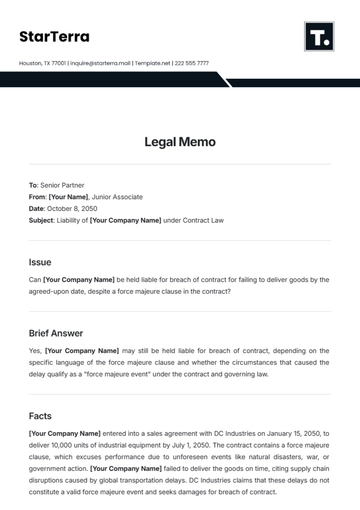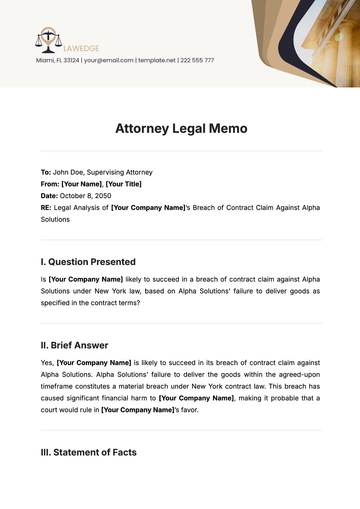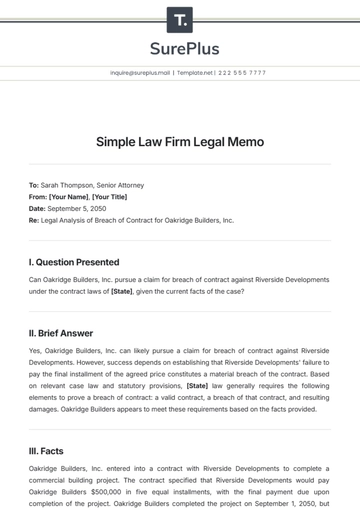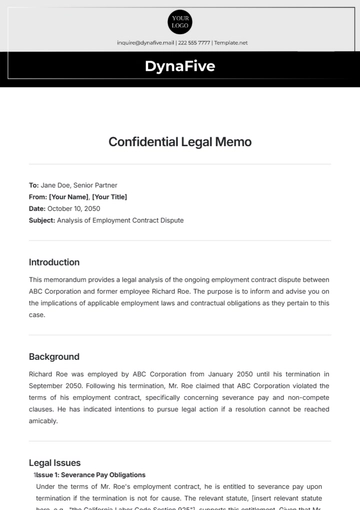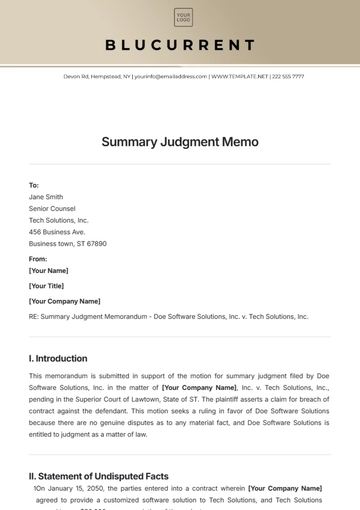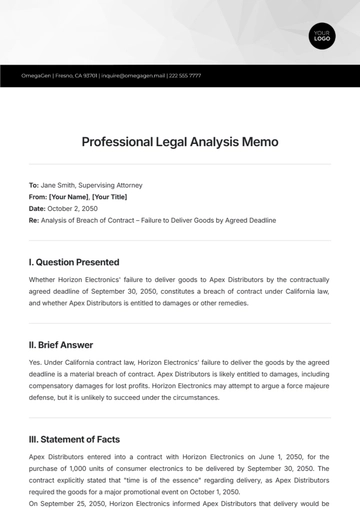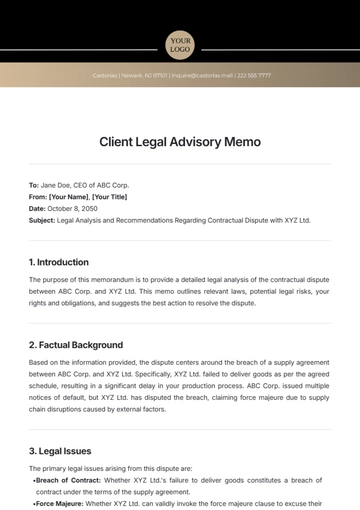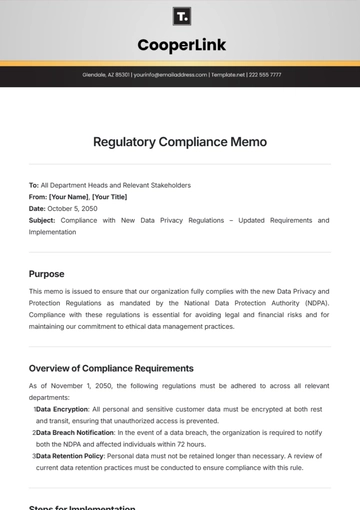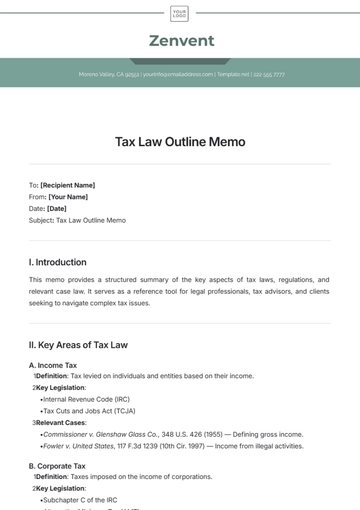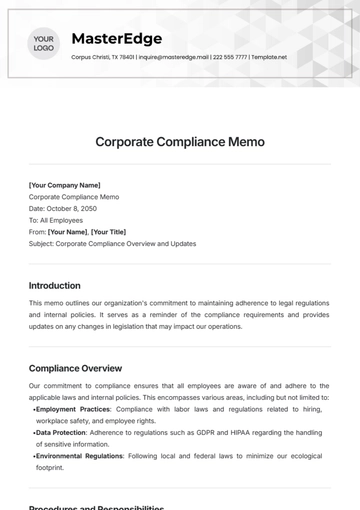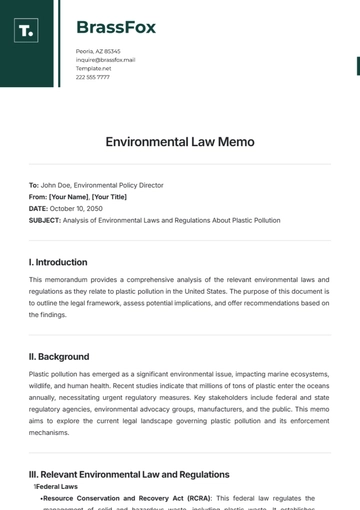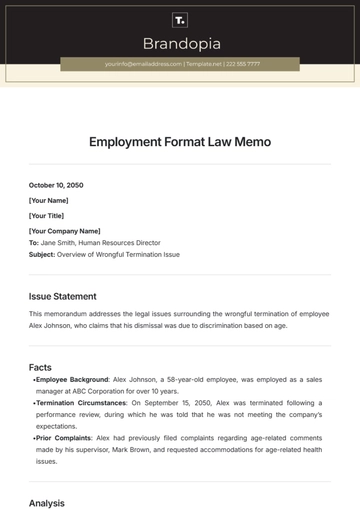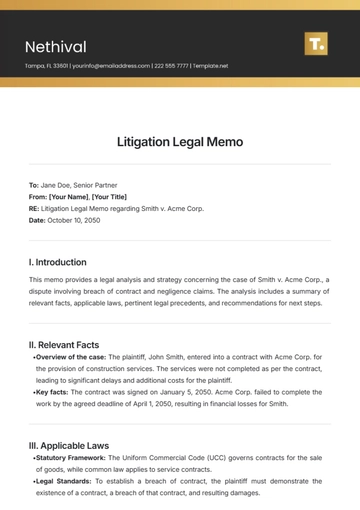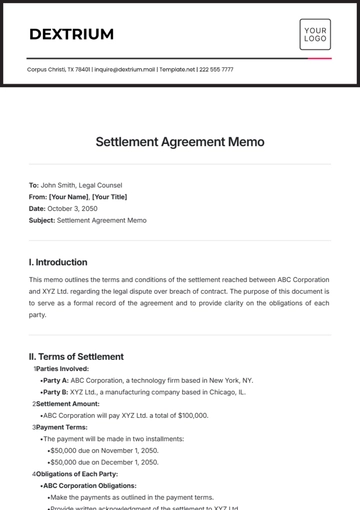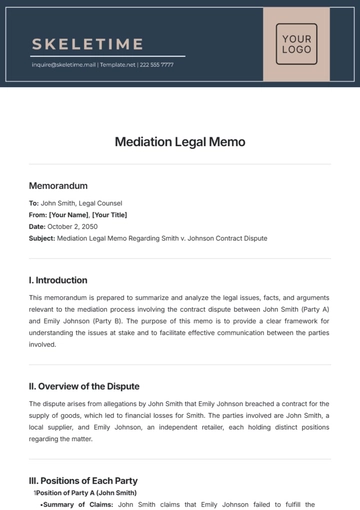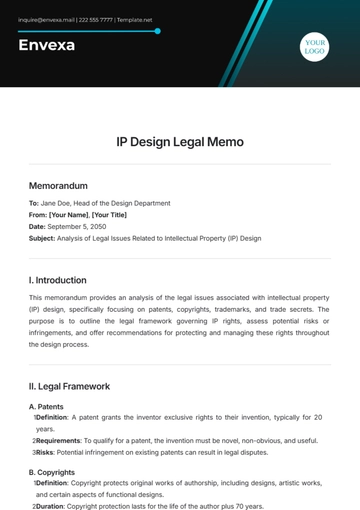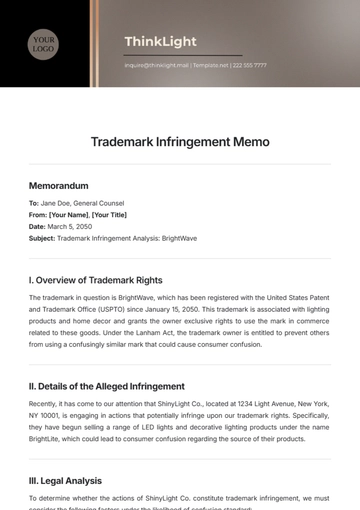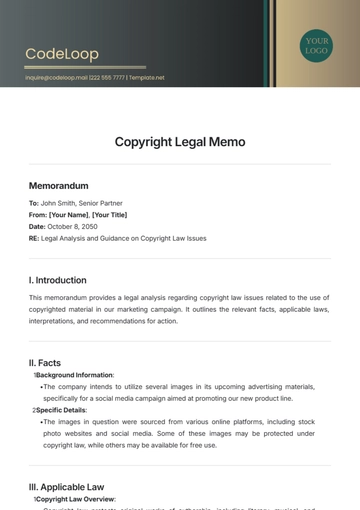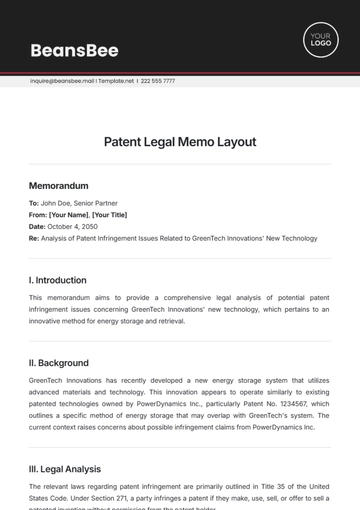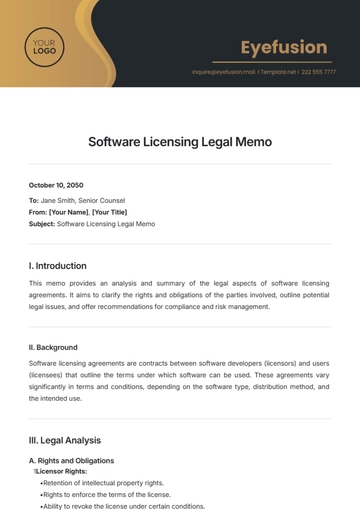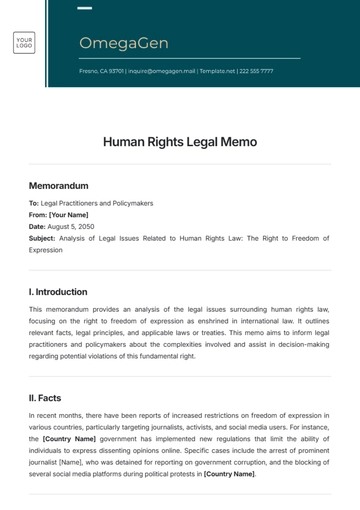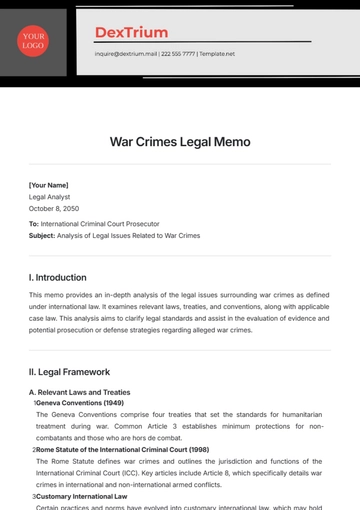Free Law Firm Legal Memo Writing Procedure
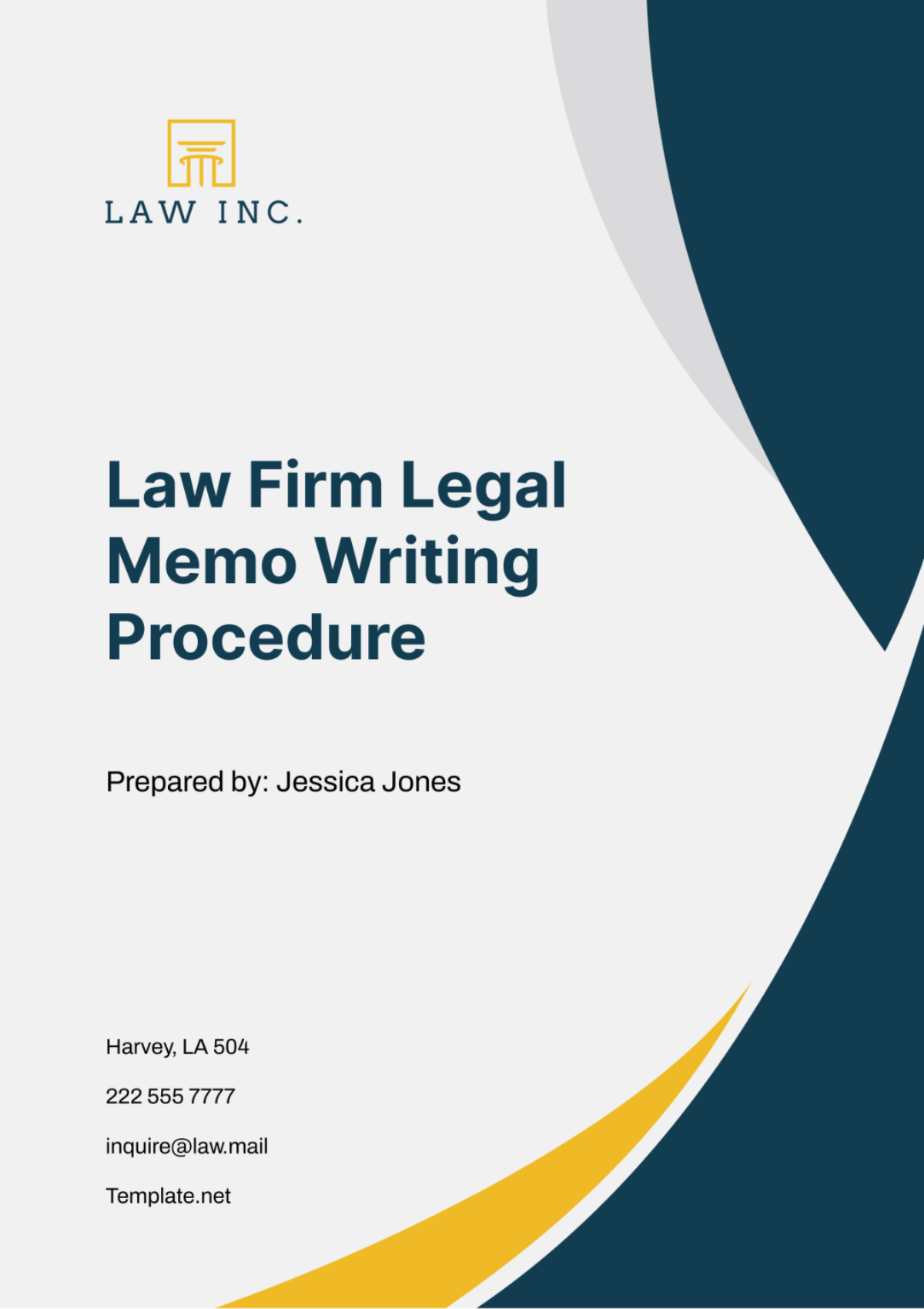
I. Introduction
A. Purpose
The purpose of this document is to establish a standardized procedure for drafting legal memoranda at [Your Company Name], ensuring consistency, accuracy, and professionalism in our legal communication efforts.
This procedure aims to provide clear guidance to attorneys and legal staff involved in the memo drafting process, facilitating efficiency and quality in our work product.
B. Scope
This procedure applies to all attorneys and legal staff at [Your Company Name] who are responsible for preparing legal memoranda, whether for internal use, client communication, or court submissions.
Compliance with this procedure is mandatory for all individuals involved in drafting legal memoranda to maintain the firm's reputation for excellence and reliability.
II. Legal Memo Writing Procedure
A. Understanding the Assignment
Review the client's request or the supervising attorney's instructions thoroughly to understand the purpose, scope, and intended audience of the legal memo.
Clarify any ambiguities or uncertainties with the supervising attorney before proceeding with research and drafting.
B. Research
Conduct comprehensive legal research using reputable sources such as case law databases, statutory compilations, legal treatises, and academic journals.
Document all research findings, including relevant statutes, regulations, judicial opinions, and secondary sources, to support the analysis and conclusions of the memo.
Resource Type | Examples |
|---|---|
Statutes | Federal statutes, state codes, local ordinances |
Case Law | Appellate court decisions, relevant judicial opinions |
Secondary Sources | Legal treatises, law review articles, practice guides |
Regulations | Administrative rules, agency guidelines |
C. Outline Development
Create a structured outline for the legal memo to organize key arguments, analysis, and supporting authorities logically.
Include clear headings and subheadings that reflect the memo's content and facilitate easy navigation for readers.
Share the outline with the supervising attorney for feedback and approval before proceeding with drafting.
D. Drafting
Begin drafting the legal memo using the approved outline and incorporating the research findings into coherent arguments and analysis.
Write in a clear, concise, and objective manner, avoiding legalese and ensuring readability for both legal and non-legal audiences.
Provide citations to relevant authorities to support legal arguments and conclusions, following the required citation style (e.g., Bluebook, APA, MLA).
E. Review and Revision
Conduct a thorough review of the drafted memo to identify any errors, inconsistencies, or areas requiring further clarification.
Seek feedback from colleagues or the supervising attorney on the draft to ensure accuracy, clarity, and completeness.
Revise the memo based on feedback received, making necessary edits to improve its quality and effectiveness.
F. Finalization
Prepare the final version of the legal memo incorporating all revisions and addressing any comments or suggestions provided during the review process.
Proofread the memo carefully to eliminate typographical errors, grammatical mistakes, and formatting inconsistencies.
Format the memo according to [Your Company Name]'s style guide, ensuring uniformity in typography, spacing, headings, and margins.
Submit the final memo to the supervising attorney for approval before distribution to the intended recipients.
III. Quality Assurance
A. Peer Review
Conduct peer reviews of legal memos within [Your Company Name] to ensure accuracy, coherence, and adherence to established standards.
Select colleagues with relevant expertise to review the memo and provide constructive feedback on its content, structure, and argumentation.
Incorporate suggestions and recommendations from peer reviews into the memo revision process to enhance its quality and effectiveness.
B. Supervisory Review
Submit the finalized legal memo to the supervising attorney for thorough review and approval before dissemination to clients, colleagues, or external parties.
The supervising attorney will evaluate the memo's legal analysis, reasoning, and conclusions to ensure compliance with applicable laws, regulations, and ethical standards.
Address any concerns, revisions, or recommendations identified during the supervisory review process promptly and comprehensively to finalize the memo for distribution.
C. Compliance Verification
Verify compliance with [Your Company Name]'s internal policies, procedures, and quality standards throughout the legal memo drafting process.
Ensure that the memo accurately represents the firm's position, reflects sound legal reasoning, and upholds professional ethics and integrity.
Document any compliance issues or deviations from established procedures for review and remediation as needed to maintain quality and consistency in our legal work product.
Compliance Area | Verification Steps |
|---|---|
Legal Accuracy | Confirm that legal arguments and analysis are well-founded |
Compliance with Policies | Ensure adherence to [Your Company Name]'s internal policies |
Ethical Standards | Verify compliance with professional ethics rules and guidelines |
IV. Documentation
A. Record Keeping
Maintain comprehensive records of all drafts, revisions, and final versions of legal memos generated by [Your Company Name]'s attorneys and legal staff.
Document the date, authorship, and version history of each memo to facilitate traceability, accountability, and quality control.
Store memo records securely in [Your Company Name]'s document management system, ensuring accessibility to authorized personnel while maintaining confidentiality and data integrity.
B. Archiving
Archive finalized legal memos in [Your Company Name]'s centralized repository or electronic database for long-term storage and retrieval.
Implement appropriate categorization, tagging, and indexing protocols to facilitate efficient searching and retrieval of archived memos based on keywords, topics, or client matters.
Regularly review and update the memo archive to ensure its completeness, accuracy, and relevance over time, purging obsolete or redundant documents as necessary to optimize storage space and organizational efficiency.
V. Training and Development
A. Training Programs
[Your Company Name] conducts regular training sessions and workshops on legal memo writing for new attorneys and legal staff.
These training programs cover topics such as structuring legal arguments, effective research techniques, citation standards, and memo formatting.
Experienced attorneys and legal professionals lead these training sessions, providing practical insights, examples, and exercises to enhance participants' memo writing skills.
B. Continuing Education
[Your Company Name] encourages ongoing professional development for attorneys and legal staff through continuing education opportunities.
Attorneys are encouraged to attend legal writing seminars, webinars, and conferences to stay abreast of best practices, emerging trends, and developments in legal memo writing.
The firm may provide financial support or reimbursement for approved continuing education activities related to legal writing and research.
Training Topic | Description |
|---|---|
Structuring Legal Arguments | Techniques for organizing legal memos to present arguments logically and persuasively |
Research Techniques | Strategies for conducting effective legal research using online databases and resources |
Citation Standards | Guidelines for citing legal authorities accurately and consistently in memos |
Memo Formatting | Standards for formatting legal memos, including headings, fonts, and spacing |
VI. Compliance
A. Ethical Considerations
[Your Company Name] adheres to professional ethics rules and guidelines governing legal writing and communication.
Attorneys and legal staff are expected to maintain the highest standards of integrity, honesty, and professionalism in all aspects of memo drafting.
Avoiding plagiarism and ensuring proper attribution of sources are paramount, with strict adherence to citation standards and copyright laws.
B. Confidentiality
[Your Company Name] prioritizes client confidentiality and attorney-client privilege in all memo drafting and communication.
Attorneys and legal staff must safeguard sensitive client information and privileged communications in accordance with the firm's policies and procedures.
Access to confidential memos is restricted to authorized personnel only, and measures are in place to prevent unauthorized disclosure or use of confidential information.
Compliance Area | Guidelines |
|---|---|
Ethical Conduct | Adhere to professional ethics rules and standards |
Confidentiality | Safeguard client confidentiality and attorney-client privilege |
Copyright Compliance | Ensure proper attribution of sources and adherence to copyright laws |
Data Security | Implement measures to protect sensitive information from unauthorized access |
VII. Conclusion
A. Compliance with this legal memo writing procedure is crucial to maintaining the highest standards of professionalism, accuracy, and integrity at [Your Company Name]. By following these guidelines, our attorneys and legal staff ensure that our legal memos effectively serve the needs of our clients and uphold the reputation of our firm.
B. Adherence to established procedures promotes consistency and coherence in our legal communication efforts, enhancing clarity and persuasiveness in our arguments and analysis.
C. Continuous training and development opportunities further strengthen our team's proficiency in legal memo writing, enabling us to deliver high-quality work products that meet or exceed client expectations.
D. [Your Company Name] is committed to upholding ethical principles, maintaining confidentiality, and complying with all relevant laws and regulations in our legal practice. By prioritizing ethical conduct and compliance, we instill trust and confidence in our clients and stakeholders, fostering long-term relationships and success for our firm.
E. Through diligent adherence to this legal memo writing procedure, we demonstrate our dedication to excellence and professionalism in every aspect of our work, positioning [Your Company Name] as a trusted advisor and partner in our clients' legal matters.
- 100% Customizable, free editor
- Access 1 Million+ Templates, photo’s & graphics
- Download or share as a template
- Click and replace photos, graphics, text, backgrounds
- Resize, crop, AI write & more
- Access advanced editor
Establish a structured approach to legal memo writing with Template.net's Law Firm Legal Memo Writing Procedure Template. This editable and customizable document outlines the systematic process for crafting concise and informative legal memos. Crafted by legal experts, it ensures clarity, accuracy, and professionalism in your firm's memo writing endeavors. Editable in our Ai Editor Tool for seamless customization and integration into your firm's workflow.
